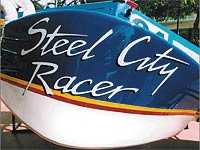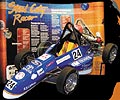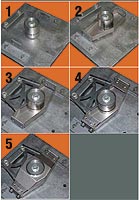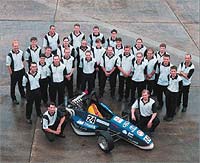Tools & Resources
Formula SAE: The Steel City Racer
| Location: | Wollongong, New South Wales |
| Country: | Australia |
| Engineer: | University of Wollongong Racing Team, Engineering Innovations Centre, Wollongong University |
| Products Used: |
CM350-G Steel |
Lightweight, strength and agility are the essential attributes of any competitive racing car, and these qualities are also paramount in Formula SAE. The Steel City Racer - designed, engineered and manufactured by the University of Wollongong Racing Team (UOW Racing) - achieves these global prerequisites by combining a number of unique design features with selection of the right material for each specific application.
The Formula SAE competition centres on the design, manufacture, testing and racing of a special class of car intended for weekend autocross events. The one year project, undertaken by enthusiastic groups of engineering students looking for a practical way to improve their skills, requires as much in the way of leadership, project management, teamwork and scheduling as it does in terms of quality engineering design.
As a result of their analysis, UOW Racing set in place a two-phase program for development of the Steel City Racer.Phase 1 included completion of the chassis, basic suspension and drivetrain, installation of a carburettor engine and a simple set of driver controls. Data logging equipment was also fitted to the Phase 1 vehicle. This would provide a driveable test bench for analysing component design, as a basis for the developments planned for Phase 2, and for training drivers.
Phase 2 upgrades included a fuel injected engine, optimisation of some suspension components, revised electrical wiring, addition of bodywork and a concept for an electronic gearshift.
Teamwork is the Key
A visit to UOW Racing's headquarters, the Engineering Innovations Centre at the University of Wollongong, sees a team that exudes confidence and professionalism.UOW Racing comprises 29 students from the Electrical and Mechanical Engineering disciplines. The team consists of four major design groups - chassis, suspension/brakes, engine and drivetrain. Each group carries full responsibility for their area of the vehicle, from design to manufacture to testing.
Driver interaction - ergonomics, control and instrumentation - was identified early on as an area also needing special attention. However, rather than form a team specifically for this function, members were seconded from the other design groups to deal with the driver interaction requirements. This had the additional benefit of optimising the integration of driver functions into each of the sub-systems.
A Project Leader was responsible for progress of the entire project and ensured that the different design groups interacted smoothly. Managers were also allocated for the specific tasks of budget control and web design.
Steel City Racer in Brief
From the high strength steel space frame and steel-intensive suspension to the dual inboard rear brakes, the Steel City Racer is a performance race car, developed and built using state of the art design and manufacturing processes.It is powered by a fuel injected Honda CBR 600 engine, and has a small footprint that grips the road surface through Hoosier racing slicks. The suspension has been carefully designed to enable adjustments to be made to the car without compromising driver safety or the vehicle's reliability.
The engine's power is transferred through a chain and sprocket to a torque-sensing differential from which two identical, steel half-shafts direct power to the rear wheels and tyres. These half-shafts also transmit the braking torque to the rear wheels from the dual inboard rear brakes. Both the front and rear brake rotors are hardcoated aluminium alloy, and the brake pedal is housed in a pedal box that is easily adjustable to accommodate different drivers. The box contains only two pedals, the clutch being integrated with a hand-operated gearshift mechanism located in the cockpit.
All of the safety structure on the Steel City Racer is ultra high-strength steel. The driver sits semi-reclined in a composite seat, head tucked below the main roll hoop and shoulders below the top rails of the cockpit.This position, combined with the six point racing harness and the anti-intrusion bars incorporated into the front A-arms, keeps the driver safe.
The cooling system features twin radiators, one mounted each side of the cockpit inside carbon fibre pods. One radiator is currently equipped with a thermostatically controlled electric fan, an option available for the second radiator if needed. A Davies Craig variable speed electric water pump circulates the cooling water. Enclosing the forward sections of the vehicle, aerospace technology is employed in the form of an ultra-light, non-structural, carbon fibre/aircraft fabric skin.
Specific Design Features
Much of UOW Racing's design effort was focussed on producing a performance vehicle, with a low centre of gravity to provide superior handling characteristics on tight courses.It was essential to meet the performance requirements while maintaining a suitable degree of cost efficiency to ensure affordability, because one of the aims of the project was to manufacture within reasonable cost. The design of the Steel City Racer encapsulates features which enhance the vehicle's performance but don't necessarily stretch the manufacturing budget.
First of all this shows in the overall dimensions. A short wheelbase of 1650mm and a track of 1300mm (front) and 1250mm (rear) reduced the overall dimensions of the car and thus its mass. The small footprint also enhances the car's manoeuvrability, making it easier to thread through the tight courses for which it was designed.
Space Frame Chassis in UltraHigh-Strength Steel Tube
Firmly at the structural centre of the Steel City Racer, the chassis was designed to be lightweight and low, with the agility and performance of the car in mind.Where structural performance is critical, the material of choice is steel, offering an unmatched synthesis of stiffness, strength and ease of fabrication, as well as other attributes which enhance the safety of the vehicle. A cost-effective tubular steel space frame construction, the chassis is made of RaceTech 650 chrome-molybdenum steel tube, with diameters and wall thicknesses selected to minimise the mass while maximising torsional and bending rigidity.
RaceTech 650, a proprietary tube made from SAE 4130 ultrahigh-strength low alloy steel, achieves its 650 MPa minimum yield strength through minor additions of chromium (~1%) and molybdenum (<0.25%). Through careful placement of the joints and attention to load paths in the design of the space frame, UOW Racing has produced a highly rigid chassis with a mass of just 34 kg, about 15% of the overall mass of the Steel City Racer.
Observing the car from the side, the lower rails of the chassis are contoured to keep the centre of mass of the car as low as possible without risk of road damage to suspension pickup points.Built on a Demmeler 3-D Modular Clamping System to ensure accurate alignment of the frame members, the space frame was TIG welded and then bead blasted and clear coated to give it an attractive, natural finish.
Suspension at a Glance
At the heart of every nimble car is a well designed suspension package and the Steel City Racer carries just such a system.Plain spherical bearings and replaceable inboard pickup brackets with adjustment shims connect the A-arms to the chassis and provide for convenient and robust setting of camber and castor. The front and rear roll centres are fixed at 20mm and 40mm above ground respectively and stay effectively constant through the range of camber and castor adjustment due to the angle of the pickup points.
Bump steer has been eliminated through careful placement of the steering rack and positioning of the pivot point. The need for anti-roll bars was eliminated through the combination of an aggressive rising rate actuation linkage and progressive rate (250-500 lb) springs. This design, combined with the vehicle's low centre of gravity, caters for both minimal bump sensitivity and high resistance to body roll under lateral acceleration.
The light and low focus also shows in the suspension. The pull rod system was chosen because it enabled the heavier components (rocker arms, shock absorbers, and springs) to be mounted between the lower chassis rails. Additionally, the pull rods can be much smaller and lighter than push rods because they support the weight of the car in tension rather than compression.
Also contributing to the light nature of the suspension system is the use of rolled tubing in the A-arms. This appropriately matches the tubes' moments of inertia to the planes in which the cornering, acceleration, and braking forces act. Another feature of the suspension is the two-piece rocker arms that straddle the frame tube and transfer the load into the space frame without any torsional loading of the members. Live centre hubs were designed for the front and rear and the rear brakes were mounted inboard on the differential output shafts.
Attached to one end of the suspension system, the wheels, hubs, uprights, tyres, and brakes also show the quality of engineering present in the Steel City Racer. These components constitute the majority of the vehicle's unsprung mass, and in order to get the best performance possible from the suspension system, their weight was minimised by combining state of the art structural design processes and selection of the most appropriate materials.
Unique Suspension Uprights
For the suspension uprights, a fabricated steel assembly was designed that would produce a highly rigid yet lightweight component. In order to optimise both mass and stiffness, a closed shell design was employed, creating an "exoskeleton" that ensures the distribution of operating stresses over the surface of a shell rather than centrally through a backbone element.
Extensive use was made of 3-D computer modelling and FEA to fine tune the uprights' dimensions, with the 2-D pattern profiles exported directly from the computer model to a CNC laser cutting machine where the steel sheet was quickly and accurately cut to shape. These blanks were CNC folded before being assembled in a jig and fully TIG welded.Due to the high stresses experienced during race conditions a higher strength steel, CM350, was selected, which has a guaranteed minimum yield strength of 350 MPa. This material was not only easy to fabricate and weld, but enabled reduction of the sheet thickness to 0.95 mm, substantially less than would be required in mild steel. The final upright design achieved significant mass benefits over an earlier prototype component, contributing towards a total 2 kg saving in unsprung mass.
If put into commercial production, the Steel City Racer would be destined for limited production volumes so it was considered vital to keep the part count to a minimum. To achieve this level of manufacturing efficiency in the suspension area, the uprights were designed to be perfectly symmetrical and use the same upper and lower pickup brackets on both left and right sides of the vehicle. This greatly reduced the overall number of components required while still providing the necessary degree of adjustment within the desired suspension geometry.The final result was a very rigid, lightweight upright that could be economically produced on a limited volume production run.
Brake Rotors
The aluminium alloy brake rotors are another major design feature. They are coated with a copper/high-carbon steel spray for heat dissipation and wear properties and employ aerospace technology in an effort to minimise their weight.Steering
Connected to the front wheels via tie rods on the bottom of the uprights, the steering system features a custom manufactured rack and pinion mounted to the lower rails of the chassis. With 180° of steering wheel input corresponding to 40° wheel motion lock to lock, the steering system gives the driver the fast response required on tight courses. The whole system is designed to achieve 100% Ackermann steering geometry and give the car superior manoeuvrability.
Engine - Light, Durable and Never Short of Breath
The engine of choice for the Steel City Racer was sourced from a 1999 Honda CBR600. The F4 engine was selected due to its light 59 kg mass and its durable design. On the Steel City Racer, the engine breathes through an intake system designed and built by UOW Racing.The intake consists of 263 mm long primary runners tuned for peak torque at 8500 rpm. Custom trumpets, welded to the inlet end of the primary runners, protrude into the 2.15 litre cylindrical plenum chamber.
This helps to equalise the air distribution to each of the cylinders and minimise the plenum volume without restricting the airflow into the trumpet bell. The entrance edge to each trumpet has been contoured to allow air to be drawn from behind the trumpet aswell as in front.
On the left end of the plenum is the 20 mmintake restrictor, a mandatory design feature of Formula SAE, that has been manufactured from acetal plastic to minimise heat transfer to the inlet air. It uses a wide-angle diffuser with an internal hollow cone. This cone shortens the overall intake length without causing excessive losses and provides for more predictable intake tuning. Feeding the restrictor is a 32mm diameter throttle body that gives no flow restriction at full throttle.
Providing fuel to the engine is a set of high resistance fuel injectors sourced from a BMW K100 motorbike. The injectors are set up to fire directly at the back of the intake valves, minimising fuel loss on the inlet walls. This arrangement requires a bend at the engine end of the primary inlet pipes but enables the injectors to be mounted as close to the valve as possible to provide impressive torque and responsiveness at low engine revs. The injectors are sequentially controlled by a Motec M8 computer which also controls the compact, lightweight inductive ignition system.
Driver Interaction
From the outset, as required by Formula SAE rules, driver ergonomics were considered by including a 95th percentile male driver in the space frame model. This follows state of the art CAE practice in the automotive industry. The measures taken to optimise driver interaction ensured that cockpit layout was appropriate and that the controls were strategically positioned for comfort and accessibility.
Linking the driver to the engine is a specially designed gear shifter with an integral clutch. Mounted just to the left of the steering wheel the shifter enables the driver to feather the clutch on take offs as well as shift quickly through the gears with or without the clutch. The shifter is a simple, lightweight system that combines with the throttle pedal to give the driver intimate control over the power train of the Steel City Racer.
Putting the Power Down
Connecting the engine to the ground is a drive train that also enhances the car's performance and further showcases the engineering talent of UOW Racing.Mounted on the same swing arms that hold the rear brake calipers, the differential assembly houses a Torsen limited slip differential allowing a torque bias ratio up to 2.8:1 when under power.
Both the modified differential housing and the lightened steel sprocket fastened to it have been optimised through detailed FEA.
Power is transferred to the differential unit through a compact 3.5:1 reduction via sprockets and chain, with tension adjustment achieved through a turnbuckle connection on each of the swing arms. The lateral rigidity of the differential unit, and chain alignment are maintained through the use of a Panhard rod and shims. The differential unit transfers the forces generated under power and under brakes into the chassis engine plate rather than directly into the rear chassis tubes. This eliminates unnecessary design compromise as it enables the rear of the chassis to be designed entirely to meet the requirements of suspension loads and geometry.
The culmination of UOW Racing's 16 months of effort is a racing car at least 10% lighter and typically 25% lighter than the Australian entrants in the 2000 event.
On the Way to the Podium
Despite their novice status in Formula SAE, the team has made impressive progress, with the Phase 1 Steel City Racer driveable by mid-August and the Phase 2 vehicle turning wheels in early October. The team's phased approach to this project has paid off, having confronted and overcome a differential failure, made changes to the driver ergonomics, and had ample opportunity to collect data on the test track. This approach, and the team's dedication and focus has led UOW Racing to be rated as a pre-event favourite.
Proof in the Driving
The weekend autocross racer demands engineering excellence that delivers on the track. In December 2001, at the Formula SAE - Australasia competition at Holden's Lang Lang proving ground, UOW Racing intends to demonstrate the high quality of its engineering design through the exceptional dynamic performance of the Steel City Racer.
Read about the Formula Team's success at the 2004 Championships:
BlueScope Steel Steers Graduates Towards a Winning Future
















